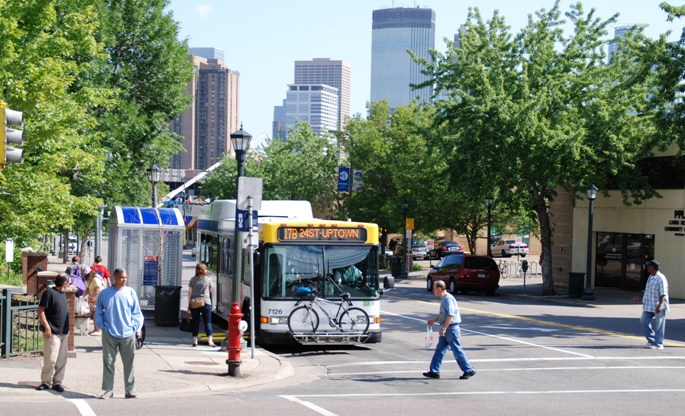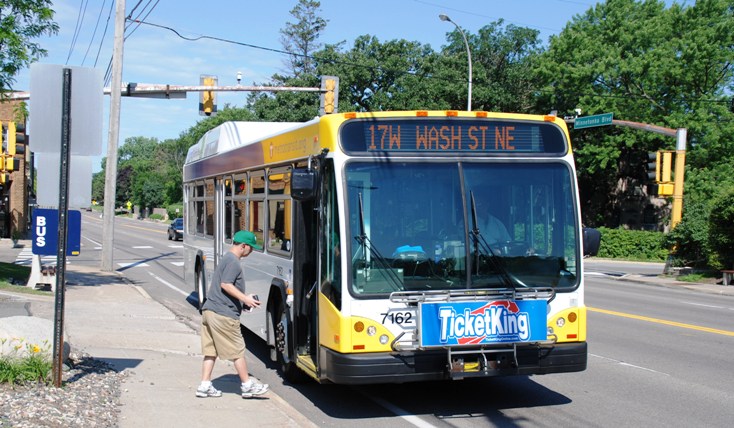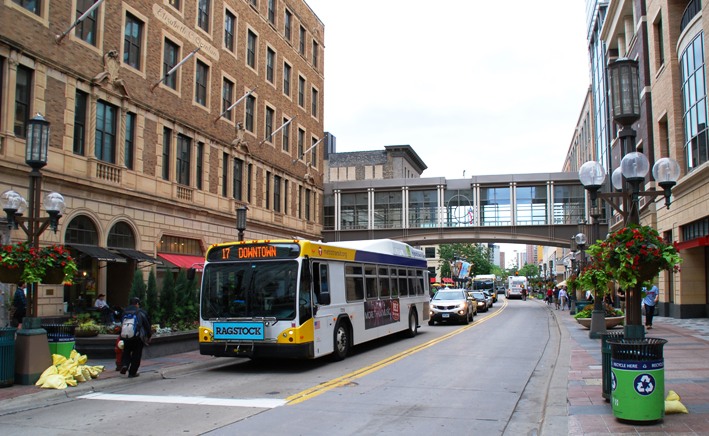 Every day for the last six years Charles Nelson has traveled across Minneapolis to see his wife at the nursing home where she lives near Lake Calhoun. Because the visits align with afternoon rush hour, he almost invariably elects to take the bus instead of battling traffic.
Every day for the last six years Charles Nelson has traveled across Minneapolis to see his wife at the nursing home where she lives near Lake Calhoun. Because the visits align with afternoon rush hour, he almost invariably elects to take the bus instead of battling traffic.
Watching cars idle on busy Lake Street, Nelson said he can’t help but wonder why anyone would want to drive under such conditions.
“It just doesn’t make sense for me as a single person to be driving a car,” Nelson said as he traveled west on Route 17. “It’s not good for me or for the environment.”
Others on Route 17 similarly describe their use of transit as a practical, common sense response to the high costs of owning a vehicle and the pressures of Twin Cities traffic. On a recent weekday afternoon, passengers were found riding the bus to visit friends, get to work and avoid the hassles of driving to a Twins game at Target Field.
Such variety is common on the nearly 12-mile route because it serves so many distinct destinations.
Traveling westbound, Route 17 runs through residential and commercial areas of Northeast Minneapolis, across the 3rd Avenue Bridge and through the heart of downtown on Nicollet Mall. The route continues through Uptown on Hennepin Avenue and Lake Street and then continues west on Minnetonka Boulevard through St. Louis Park. Most trips end near Knollwood Mall, but some end near 36th Street and Wooddale on a branch that serves several large employers.
Bobby Watkins is among those who travel on Route 17 on a daily basis. Watkins lives in Northeast Minneapolis and takes the bus to get to his job at the Dairy Queen near 50th and France (transferring from Route 17 to Route 6 at the Uptown Transit Center).
Watkins owned a vehicle for a few years but went car free three years ago when he faced an $800 repair bill. Instead of paying for car repairs, he puts his money toward a 31-day Go-To Card pass that allows him unlimited rides for $59 (rush-hour 31-day passes are $85 a month).
“The car just cost too much,” he said. “Breaking down once was about the same as a few months bus fare.”
Korissa Ebersole also uses transit as a way to save money. But as a new mother, she also likes the fact that she can cradle her seven-month-old child while riding the bus.
 “She really likes to be held and is a lot less fussy on the bus,” Ebersole said, returning downtown on Route 17 after having lunch with a friend.
“She really likes to be held and is a lot less fussy on the bus,” Ebersole said, returning downtown on Route 17 after having lunch with a friend.
Sitting next to Ebersole was Angela Record, who was headed to her job as a cleaner at Target Field. Record said she takes the bus to work and for most other trips because it’s a more relaxing, enjoyable experience.
“People don’t like to follow the rules of the road,” she said. “This feels so much safer to me.”
Rayla Heflin also sees the bus as a safer travel option. Heflin has a car but takes Route 17 to and from her jobs at Taco Bell and T.J. Maxx in St. Louis Park because she finds it hard not to look at her phone while driving. Riding the bus allows her to text, play games and listen to music all she likes.
“I try to limit it, but sometimes I get involved and miss my stop,” Heflin said. “I know if I was in the car and I was too focused on my device something a lot worse might happen.”
Bob Kelley also uses the bus as a way to keep himself in check. Car-free for the last three years, Kelley takes Route 17 to get to his job in Uptown and to visit friends in Northeast Minneapolis. Besides saving money on gas, insurance and car repairs, taking the bus also has a way of limiting his spending at the store.
“This helps keep my shopping trips to a minimum because I only buy what I can fit in my bag,” he said.
While many on Route 17 have made taking the bus a part of their daily routines, St. Louis Park resident Jane Nelson, her son and his girlfriend were making a rare trip to Target Field.
Looking to avoid traffic and parking, Nelson called Metro Transit’s Transit Information Center and learned Route 17 would provide a simple, one-seat ride to the ballpark.
“I just don’t know downtown very well so I thought it would be easier to walk to the bus stop than to try and figure out how to get around,” she said. “It was a lot easier to just go the four blocks to the bus stop.”
 Route 17 At a Glance
Route 17 At a Glance
Type: Urban Local
Service: Route 17 serves Northeast Minneapolis, downtown Minneapolis, Uptown and St. Louis Park. Traveling southbound, buses run on Washington and Central avenues and through downtown on Nicollet Mall. Buses continue on Nicollet Avenue and 24th Street, stopping at the Uptown Transit Center on Hennepin Avenue before going to St. Louis Park on Lake Street and Minnetonka Boulevard (Route 17F goes south at Highway 7 to provide a connection to multiple employers in St. Louis Park). On the west end, Route 17 runs on Texas Avenue, serving Knollwood Mall and residential areas. Buses run every 5 to 15 minutes during rush hour, every 15 minutes midday and every 30 minutes in the evening. Service runs every 15 to 30 minutes on weekends and holidays. Service hours are approximately 5 a.m. to 2 a.m.
Route Length: Approximately 12 miles
Stops: 123 eastbound, 125 westbound
Vehicles: 40-foot standard and hybrid-electric buses
Ridership: Approximately 2.1 million customer boardings in 2013, the ninth highest ridership among all Metro Transit bus routes.
History: Buses, including some of the first gas-electric models, began running on Nicollet and Hennepin avenues in the early 1920s. A streetcar line that ran from Hennepin and Lagoon avenues to Lake Street and Brownlow Avenue operated from 1892 to 1938. The Richfield Bus Co. operated buses on the far west end of what is now Route 17 until Twin City Rapid Transit took it over in the 1950s. The northeast section of the route is rooted in a horsecar line that opened in 1892 and ran from downtown Minneapolis to Broadway and Monroe streets, where Logan Park is now located. Horsecars were replaced with electric streetcars, which operated until 1954.
Future: Concept plans for the Southwest LRT project call for Route 17 to be extended to the proposed Blake Road Station.